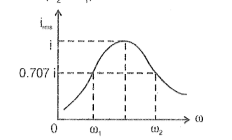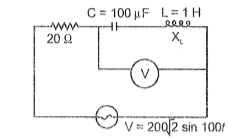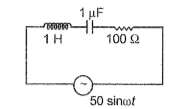The quality factor of the series resonant circuit is
When alternating current flows through a conductor, the rate of flux change
1. Is higher in the inner part of the conductor
2. Is lower in the inner part of the conductor
3. Is uniform throughout the conductor
4. Depends on the resistivity of the conductor
In a step-up transformer, the turn ratio is \(1:20\). The resistance of \(100~\Omega\) connected across the secondary is drawing a current of \(2~\text{A}\).
What are the primary voltage and current respectively?
1. \(100~\text{V}, 0.5~\text{A}\)
2. \(200~\text{V},10~\text{A}\)
3. \(10~\text{V}, 40~\text{A}\)
4. \(10~\text{V}, 20~\text{A}\)
An ideal inductor of 20 H is joined in series with a resistance of 5 ohms and a battery of 5V. The current flowing in the circuit after 4s is ( in amperes)
The RMS value of the current in a series LCR circuit is plotted with angular frequency as shown below. The ohmic resistance is R, inductance is L and capacitance is C in the circuit. The value of the difference (is

In the circuit diagram shown below, the reading of the a.c. voltmeter is

1. 200 V
2. 100 V
3.
4. zero
In a series RLC alternating current circuit, the r.m.s. value of current is , the average power loss in the circuit is
A step-down transformer transforms 200 V to 100 volts. If the current in primary and secondary coils are 6 A and 9.6 A respectively, the efficiency of the transformer is
1. 60%
2. 70%
3. 80%
4. 90%
An ideal inductor connected to a cell is shown in figure. Select the correct relations between readings of ammeters just after the switch is closed and a long time after closing the switch

The power dissipated in the following circuit will be about half of its maximum value at approximately







